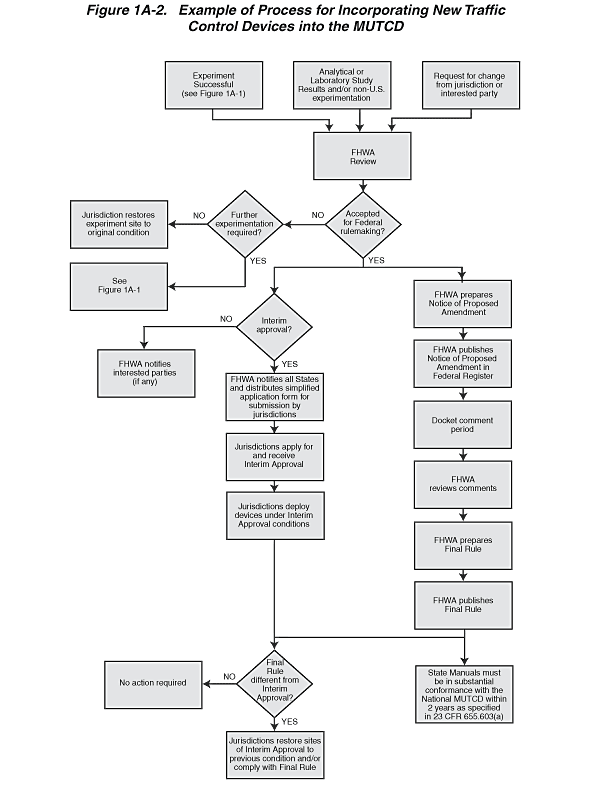|

Figure 1A-2. Example of Process for Incorporating New Traffic Control
Devices into the MUTCD
This figure shows an example of the process for incorporating new
traffic control devices into the MUTCD. This process is shown as
a flow chart:
- The flow chart begins with a successful experiment (see Figure
1A-1), analytical or laboratory study results and/or non-U.S.
experimentation, or a request for change from the jurisdiction
or an interested party, each of which may lead to the FHWA review.
The FHWA review leads to a determination of whether the new traffic
control device should be accepted for Federal rulemaking.
- If the new traffic control device is not accepted for Federal
rulemaking, the review determines if further experimentation is
required. If not, the jurisdiction restores the experiment site
to the original condition. If further experimentation is required,
then see Figure 1A-1.
- If the new traffic control device is accepted for Federal rulemaking,
the FHWA both considers the device for Interim Approval and prepares
a Notice of Proposed Amendment, in parallel processes.
- If the FHWA decides not to grant Interim Approval, the FHWA
notifies any interested parties.
- If the FHWA does grant Interim Approval, FHWA notifies all States
and distributes a simplified application form for submission by
jurisdictions. The jurisdictions then apply for and receive Interim
Approval and deploy the devices under Interim Approval conditions.
- If the FHWA accepts the new traffic control device for Federal
rulemaking, FHWA prepares a Notice of Proposed Amendment and then
publishes it in the Federal Register. A docket comment period
then begins, and the FHWA reviews any comments. The FHWA then
prepares and publishes the Final Rule. State Manuals must be in
substantial conformance with the National MUTCD within 2 years
as specified in 23 CFR 655.603(a).
- If the Final Rule is different from the Interim Approval, jurisdictions
restore sites of Interim Approval to previous conditions and/or
comply with the Final Rule. If the Final Rule is not different
from the Interim Approval, no other action is required.
Back
to Chapter 1A
|

